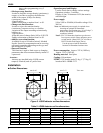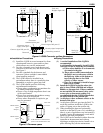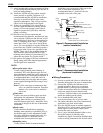
LQ500
5
110
(4.3”)
(119)
(4.7”)
Converter
communication port
Steel pipe
(50A) (2”)
360 (14.2”)
390 (15.4”)
234 (9.2”)
Contact signal I/O port (1)
Contact signal I/O port (2)
Density signal output port
Reserved
Grounding terminal
In the case of Wall mounting
In the case of 50A (2”) mounting
Steel pipe U bolt
(M10)
Converter power
supply cable port
74 (2.9”)
74 (2.9”)
320 (12.6”)
(25)
(1.0”)
(15)
(0.6”)
15
(0.6”)
45
(1.8”)
360 (14.2”)
360 (14.2”)
Unit: mm
Weight: 7kg(15 lb)
Figure 4. LQ500 Converter outline dimensions
■
Installation Precautions
(1) Install the LQ500 in an environment free from
vibration and corrosive gases and in a place
which allows easy on-site maintenance.
(2) Provide a clearance space both detector and
converter to the front, rear, and above the unit.
See Figure 5.
(3) Provide a sunshade for the detector and
converter if direct sunlight is unavoidable
when installing outdoors.
(4) The LQ500 cannot be installed in an
environment where there is a possibility that
flammable or explosive gases may leak.
(5) The LQ500 should avoid the following
environmental installations:
• Places where condensation accumulates due
to sudden temperature changes.
• Places of low or high temperature that is out
of the specification.
• Places near equipment that produces strong
electric waves or electrolytes.
• Places where flammable or explosive gas
may be generated.
500 (19.7”)
600 (23.6”)
Maintenance
s
p
ace
Back
Front
Detector
Converter
RF part
A
500 mm (19.7”) maintenance
space is also needed above unit.
500 (19.7”)
600 (23.6”)
600 (23.6”)
500 (19.7”)
Maintenance
s
p
ace
Unit: mm
Figure 5. Clearance space
■
Piping Precautions
(1) A vertical installation of the LQ500 is
recommended.
Avoid installing horizontally (install LQ500
vertically) in case of following environments.
a) Places where bubbles or environments
air remain in the pipe.
b) Places where solids concentration in
the fluid is not even because solids in
the fluid stay either at the bottom or
top of the pipe due to slow fluid
velocity or other reason.
c) Pipe size is enlarged to install a larger
meter sized LQ500.
(2) Install the LQ500 in a pipeline where the
pipe is always filled with fluid and without
bubbles or entrapped air. If these conditions
are not satisfied, the measured value varies
or may give an inaccurate reading. It is
recommended that the LQ500 is installed at
the outlet instead of the suction side.
(3) Avoid places where sediment collects at the
bottom of the pipe.
(4) Avoid places where air gets into the fluid. To
avoid this problem, install the LQ500 to the
outlet of a pump, not to the suction side.
(5) When installing the detector horizontally,
install it so that the RF-part of it is oriented up
(that is, a pair of applicators stay horizontally)
to make it easier for maintenance work and to
obtain its specified performance.
(6) The LQ500 can be installed in either direction
(upstream or downstream) and without
requiring a straight pipe section. Install it in a
place allowing easy on-site maintenance.











